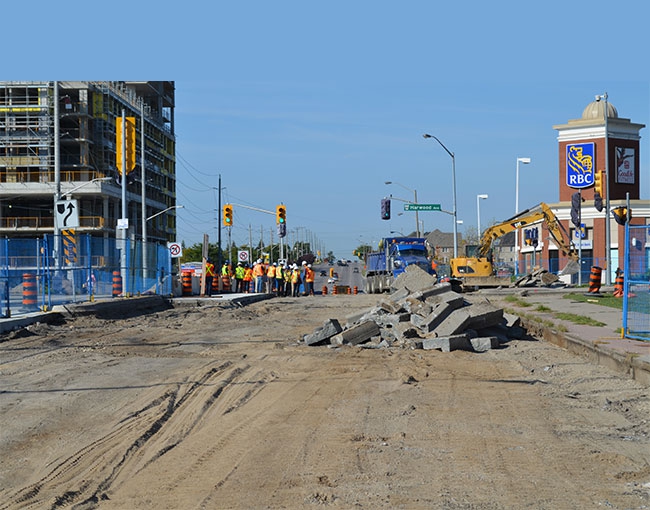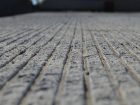
News
Concrete crossroads
Durham Region turns to concrete for intersection repairs
February 2, 2017 By Andrew Snook

The Region of Durham in southern Ontario is looking for new solutions to combat major rutting and shoving issues it is experiencing on asphalt pavements across major arterial intersections. One of the solutions it is testing is a pilot project to determine if concrete is a suitable alternative to solve some of the issues the region is experiencing at various intersections. The municipality chose the intersection at Harwood Avenue and Bayly Street in Ajax, Ont. for the pilot.
“We noticed that our typical asphalt designs have not been holding up on some of our busier roads, so over the past couple of years we’ve been developing a new standard for our major arterial intersections,” explains Ben McWade, project manager for Works Department Transportation Design at the Regional Municipality of Durham. “This particular intersection was exceptionally rutted and needed to be addressed immediately… we initiated this pilot project to see if a jointed plain concrete design would be a more suitable alternative at these kinds of intersections.”
The promise of concrete’s ability to stand up to the long-term heavy traffic the intersection experiences from high volumes of heavy trucks and buses is what sold the idea to McWade. The concrete pavement’s performance is going to be evaluated over time and compared to similar locations where asphalt designs have been implemented.
The closing date for the pilot project’s tender was May 19, 2016 and it had four companies bid on the project. Dufferin Construction ended up winning the bid and was awarded the contract, which was valued at just under $1.2 million. The project took place over the course of the summer, consisting of the removal of asphalt and granulars, concrete curb and sidewalks; and the construction of concrete pavement, concrete curbs, subdrains, PVC watermain and concrete sidewalks. The design consisted of full-depth asphalt removal (+/- 150-250mm thick); placing 100-mm thick Granular A; paving 200-mm thick, 32MPa Class C-2 concrete; sawcut joints at +/-4.25m spacing; using dowels or tie bars across the sawcuts; and a new curb and gutter.
One of the challenges that had to be watched closely during the project was consistent 30C weather, which can present challenges for concrete placing and curing. Despite the hot weather, the project ran very smoothly according to Alen Keri, technical services engineer for Concrete Ontario. Dufferin completed the concrete paving using fixed forms and a vibratory roller screed. This allowed them to work within the confines of the existing curbs and around the traffic medians. Since this project had the luxury of having a construction site that was isolated from traffic, accelerated concrete mix designs were not utilized but are always an option, if required.
Concrete maturity testing was also completed by Dufferin to cover all the bases for the pilot project. This involved monitoring the internal temperature of the concrete slabs, correlating this temperature to calibration curves and determining when the in-place concrete has reached a minimum of 20MPa to be suitable for traffic loading. Maturity testing can significantly reduce the delay in opening the roadway to traffic.
Learning curve
Since it was his first time designing with concrete paving, McWade says there was a bit of a learning curve.
“The design was put together in-house and then we hired Golder to do the geotech and the make-up,” he says. “As far as the challenges go, just learning the ins and outs of concrete design versus asphalt, the biggest difference is the joint layout design – where all the saw cuts are going to go – and then designing all the dowels, the tie bars and the spacing and deciding where to put them and where not to put them.”
The team at the Region of Durham spent a significant amount of time focusing on the construction staging aspect of the project.
“Right off the bat we thought the biggest holdup would be the staging and curing times for the concrete, but we found that the curing of the concrete wasn’t that critical,” McWade says. “It cured up pretty quickly. We just used normal 32Mpa C2 concrete, and it was cured in 16 to 20 hours to get to 20Mpa.”
The region closed off the intersection one half at a time. McWade says it wasn’t all that different from paving with asphalt.
“We still would have needed that room to reconstruct the watermain and pave the asphalt,” he says. “It might have been closed a little bit longer for the concrete paving but it was pretty similar.”
McWade believes there will be more pilot projects popping up in the future.
“It’s not something we would do everywhere, but it’s definitely something we will be considering moving forward,” he says.
To read the full-length version of this article, visit www.rocktoroad.com.
Print this page


